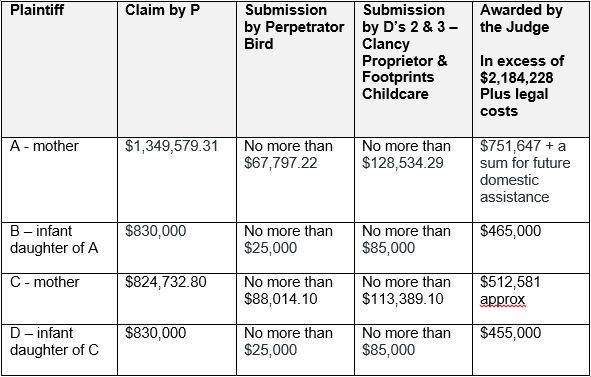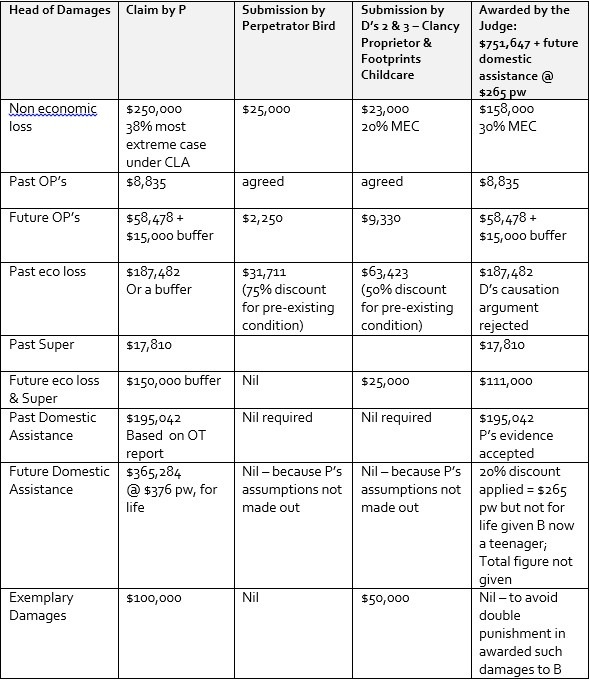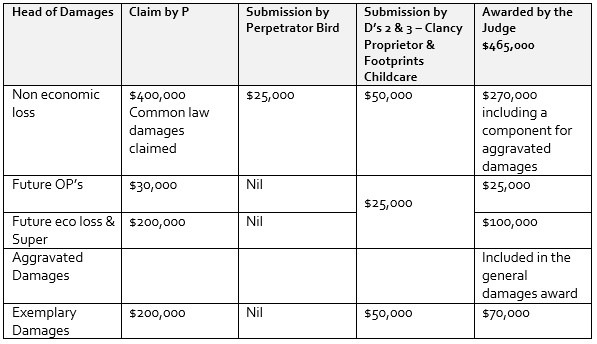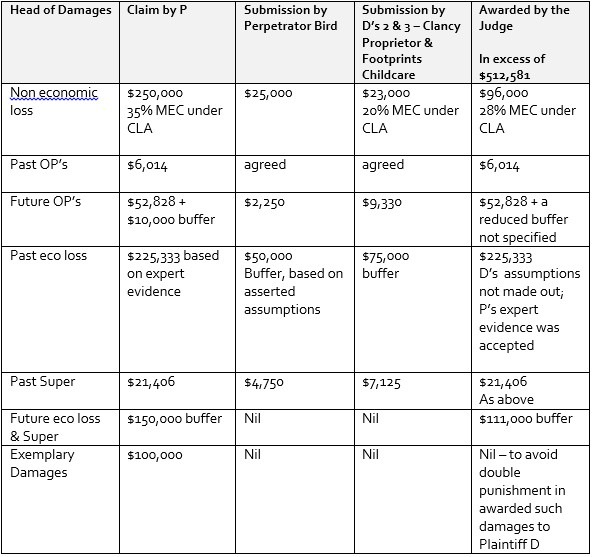ABCD v Bird & Ors [2020] NSWSC 1379 – Part B: Damages Awards in Historic Abuse Matters Nationally
 Karen Stott, solicitor and nationally accredited mediator, continues her comprehensive case summary of ABCD v Bird & Ors [2020] NSWSC 1379. In Part A, she focuses on liability issues while in Part B, she delves into the award of damages.
Karen Stott, solicitor and nationally accredited mediator, continues her comprehensive case summary of ABCD v Bird & Ors [2020] NSWSC 1379. In Part A, she focuses on liability issues while in Part B, she delves into the award of damages.
Background
This matter involved multiple claims in respect of historic child sex abuse occurring at the hands of a perpetrator in his 60’s at a childcare centre in around 2010. The decision is a salient reminder to childcare centres about the absolute necessity to abide the statutory requirements – the Children’s Services Regulation NSW) having been applicable here.
This decision also has wider significance for any organisation involved with the care of children – be they government, religious, sporting, community, charitable bodies or the like. The approach to assessment of damages which arose in this case (including claims for aggravated and exemplary damages as against employers) also apply to a wide range of historic child sexual abuse claims in the context of an area of the law that is evolving under the anxious eye of stakeholders on both sides.
The damages awards in respect of each of the 4 Plaintiffs were as follows:

It is interesting to note the huge discrepancy between the respective submissions by the parties. I assume that the seemingly minimal figures submitted by the Defendants were because of the legal and evidentiary issues – the age of the infant Plaintiffs at the time, their limited recollection, and issues of remoteness and foreseeability with respect to resulting damage to the Plaintiff mothers. On such issues in relation to the mothers’ claims, Her Honour essentially preferred the expert evidence of the Plaintiffs’ forensic psychiatrists (Dr Allnutt) over that of the Defendants (Dr Smith).
In relation to the childrens’ claims, there was more scope for agreement by the parties’ experts with regard to prognoses, however Her Honour’s damages awards made provision for the uncertainty of the girls’ futures and potential for further detriment flowing from the Defendants’ tortious acts.
The judgement is of particular significance owing to the verdict in favour of all Plaintiffs as against all three Defendants, in excess of $2,184,228 and involving:
- The apparent application of common law damages with respect to the claims by infant victims B and D, and the application of Civil Liability Act 2002 NSW (CLA) damages to the Plaintiff mothers’ claims, although exemplary damages were contemplated with respect to the mothers’ claims;
- Awards of aggravated and exemplary damages against all Defendants;
- Significant damages awards in respect of the then infant Plaintiffs, whose respective recollections of the abuse, was very limited and the expert psychiatric evidence was in agreement that they each had essentially recovered from their respective conditions and each had a favourable prognosis;
- Findings that each of the Plaintiff mothers were owed a duty of care by the Defendants and also satisfied the test for nervous shock claims under the statutory scheme (Civil Liability Act NSW) and at common law;
- Significant damages awards in respect of the Plaintiff mothers, including for non-economic loss, economic loss and the need for past and future domestic assistance.
A breakdown of the damages awards and components is discussed below.
Plaintiff A – mother
The Judge awarded damages of approximately $751,647 + a sum for future domestic assistance.
The Plaintiff had claimed $1,349,579.31 plus costs, disbursements and interest. Mr Bird’s case was that no more than $67,797.22 would be awarded and the other Defendants contended for no more than $128,534.29.
Her Honour found that the Plaintiff had a chronic condition, guarded prognosis; good progress in her pursuit of recovery, but vulnerability to relapse and further injury. The Judge preferred the Plaintiff’s expert psychiatrist Dr Allnutt (diagnosing PTSD) over that of the Defendants’ Dr Smith (diagnosing an Adjustment Disorder). The Plaintiff’s occupation was a child, youth and family worker and detailed evidence was tendered regarding her medical records, claim for economic loss and need for domestic assistance. The defence argued that the Plaintiff already had PTSD prior to the events in issue – which was not accepted by the Judge.

Plaintiff B – former infant
The Judge awarded damages of $465,000
The Plaintiff had claimed $830,000 plus costs, disbursements and interest. Mr Bird’s case was that no more than $25,000 would be awarded and the other defendants no more than $85,000.
B had received counselling from a psychologist at the Sydney Children’s Hospital from age 5 to 8. The judge accepted the P’s expert psychiatrist’s evidence that she had suffered PTSD as a result of the abuse, which was in remission. She required no further treatment in the foreseeable future and there were no foreseeable mental health restrictions or limitations. There was no challenge to this evidence.
Her Honour also found, however, that “the injury which Mr Bird caused has left her vulnerable to relapse. No-one can predict how she might be affected by experiences which life will inevitably bring her, but her injury has made B vulnerable in a way that did not exist before Mr Bird assaulted her, which must be taken into account when damages are assessed.”
The defence case was that the award, if there was one, would necessarily be very modest, given B’s full remission for at least the last two years, with no foreseeable mental health restrictions or limitations.
Her Honour found that: “the defence case cannot be accepted. It pays insufficient attention to the horrible consequences of Mr Bird’s acts which B, while still a young child, had to endure for years afterwards, pain and suffering which she would not have had to experience, had he not injured her as he did…. It may not be overlooked that B is being compensated for the serious injury she was caused when such a young child while in the defendants’ care and control, at the childcare centre which they operated, where she should have been safe.”

In awarding exemplary damages, Her Honour stated (from 670-674):
(The case law) requires both that the damages awarded punish Mr Bird and deter others from conduct of the kind which he pursued. Thus relevant is not only what Mr Bird did to B, but also how he abused the position of authority and trust in which he knew he had been placed by Little Pigeon and Ms Clancy, when they gave him access to B, while operating Footprints for their own profit.
In the pursuit of their profit they did not ensure that the regulatory regime was complied with, that the child protection policy was operating and Mr Bird was supervised as he needed to be, given the age of the children he was working with. Mr Bird was well aware of this and so was able to exploit their neglect, in order to assault B in the ways I have discussed.
It is he who must be punished for what he so did and others like him who must be dissuaded from so pursuing such opportunistic, damaging behaviour. That is because there are many others now in Mr Bird’s position, given access to the youngest and most vulnerable members of our community, while they are being cared for in centres such as Footprints, where their parents must leave them, in order to work for the overall economic good of our society.
Her Honour found that:
“the defence case cannot be accepted. It pays insufficient attention to the horrible consequences of Mr Bird’s acts which B, while still a young child, had to endure for years afterwards, pain and suffering which she would not have had to experience, had he not injured her as he did…. It may not be overlooked that B is being compensated for the serious injury she was caused when such a young child while in the defendants’ care and control, at the childcare centre which they operated, where she should have been safe.
Deterrence is thus a very important aspect of this head of damage. That supports the conclusion that a substantial award of exemplary damages is required.”
Plaintiff C – mother
The Judge awarded damages of approximately $512,581.
The Plaintiff claimed $824,732.80 plus costs, disbursements and interest. Mr Bird’s case was that no more than $88,014.10 would be awarded and the other defendants no more than $113,389.10.
C had been a Project Manager at a charity, working 4 days a week at the time of her daughter D’s disclosures. Afterwards she found it difficult to maintain her regular hours and resigned from her position after Mr Bird’s charges were dropped in 2012 – regarding which she was angry, distressed and significantly emotionally affected.
After she resigned C was off work for some 6 months and then undertook some sporadic casual projects, before returning to work in August 2013, 20-30 hours per week. At times, however, she required periods of extended leave, or leave without pay, due to mental health issues, including before and after contributing to the Royal Commission into Institutional Responses to Child Sexual Abuse, associated with the trauma of dealing with that process. At that time D’s condition also deteriorated.
Dr Allnut and Dr Smith agreed that C did not have any pre-existing history of mental illness and that causation was established. Dr Allnut was of the opinion that C was suffering a chronic adjustment disorder and Dr Smith that she had an adjustment disorder with mixed depression and anxious mood. Dr Smith observed that the litigation had been an ongoing stressor, as had the need to deal with matters of ongoing concern, which had a continuing effect upon her. Dr Smith was more positive about C’s prognosis than Dr Allnut, who considered it guarded for the foreseeable future. Dr Smith considered it to be good, particularly with early resolution of the litigation.

Plaintiff D – former infant
The Judge awarded damages of approximately $455,000
The Plaintiff had claimed $830,000 plus costs, disbursements and interest. Mr Bird’s case was that no more than $25,000 would be awarded and the other defendants no more than $85,000.
Her Honour noted the expert evidence as follows (724 – 729): On the assumption that Mr Bird had abused D as she disclosed, in their joint report Dr Robertson and Dr Kasinathan agreed that she developed a diagnosable psychiatric disorder and was likely to have experienced transient exacerbation of her symptoms, likely attributable to her mother’s contributions to the Royal Commission. Fortunately, there was no evidence of psychopathology at the time of their examinations, when she was following a normative trajectory.
They also agreed while D did not require any current treatment, she did require a process of regular monitoring of her mental health, through her GP on an annual basis, unless a more urgent need arose as the result of emerging psychological distress, behavioural disturbance, or decline in her relationships or academic performance, when more specialist review could be required. The cost of this was difficult to assess.
Dr Robertson and Dr Kasinathan acknowledged the risk to later mental health which child sexual abuse posed, but considered that at present D’s prognosis was favourable. There was no current impaired academic function and no realistic expectation of impaired work capacity.
There was a theoretical risk of re-victimisation, but no evidence of any current concerns. If D were to experience a relapse, it was possible that she would require treatment for the re-emergence of post traumatic stress disorder or related conditions.
They also agreed that D had experienced symptoms of childhood PTSD, a recognised typical short-term and ongoing effect of childhood sexual abuse. It was also recognised that childhood sexual abuse was linked to an array of psychopathological disturbances, substance use, vulnerabilities to sexual re-victimisation and heighted risk of physical health problems.
There was no immediate concern about her overall state of health, but her history had to be kept in mind by future health care workers.

Judicial Approaches to Damages for Historic Child Sexual Abuse Nationally
Recent decisions in this area have shown that when a Plaintiff is successful in overcoming the significant legal and evidentiary hurdles to proving liability, the quantum and range of damages awarded are considerable, as set out below.
More recently and particularly in the case of A, B, C & D v Bird & Others, Defence causation arguments regarding contributing factors unrelated to the events sued upon, appear to result in a particular percentage reduction for vicissitudes being applied by the Judge, rather than any significant reduction in damages such as anything like the range of 50% to 75% that is often submitted.
As such, this most recent decision may well raise the expectations of Plaintiff lawyers and their clients for the purposes of attempted settlement negotiations.
That said, despite the quick summary of damages awards below, it remains somewhat difficult for legal advisers to predict what a Court may award for any particular case at hand, as this will always turn on the particular facts of the matter. Issues such as the nature of the abuse, the plaintiff’s diagnosis and prognosis, impact of the abuse on other heads of damage such as earning capacity and causation generally – as well as whether the common law or a statutory regime with a cap on damages applies, must all be taken into account.
Ms P v Mr D [2020] NSWSC 224 – an award of $853,550 including $275,000 for general & aggravated damages and $100,000 for exemplary damages, where the plaintiff was abused by her stepfather from age 15 and gave birth to his child at age 16
Perez v Reynolds [2020] VSC 537 – an award was made in excess of $1.5M including $265,000 for general damages
KS v GR [2020] NSWDC 73 – an award of $622,182 including general damages of $300,000 and $50,000 for aggravated damages, where the plaintiff was abused by her stepfather from ages 2 to 14, the abuse having occurred over 60 years ago.
Lawrence v Province Leader of the Oceania Province of the Congregation of the Christian Brothers [2020] WADC 27 – an award of $1,329,500 including $400,000 for general & aggravated damages, (but no award for exemplary damages as claimed) where the plaintiff suffered sexual and other abuse from age 9 in 1952 as an immigrant from the UK living in an orphanage run by the Christian Brothers
Waks v Cyprys & Ors [2020] VSC 44 – an award of $804,170 including $200,000 for general damages, in respect of sexual abuse of the plaintiff as a 13 year old in 1988 by his teacher
MC v Morris [2019] NSWSC 1326 – an award of $3,510,513 including general damages of $400,000, interest of $115,000, $134,304 for domestic care, $20,000 medical expenses and the balance in past & future economic loss – damages being assessed at common law. The claim involved “regular, traumatic and violent sexual assaults” on the plaintiff as a 13 year old from 1996 to 1998, where the defendant had been convicted and was in prison.
P2 v D2 [2019] NSWDC 84 (29 March 2019) – an award of $650,670 including general damages of $300,000, where the child sexual abuse had occurred 40 years ago
HL v HP [2019] ACTSC 299 – an award of $150,000 including $110,000 for general damages and $25,000 for aggravated damages, where the claimant was aged 14 at the time of the sexual assault in a domestic setting and the defendant was aged about 21 years.
SM v SRK [2019] SADC 184 – an award of $744,093 incl $130,000 for general damages and $50,000 for aggravated damages, regarding child sexual abuse brought against the adoptive father of the claimant.
Hand v Morris & Anor [2017] VSC 437 – an award of $260,000 for general damages and $420,000 for economic loss
DC v State of New South Wales [2016] NSWCA 198 – an award of $537,000 for DC and an award of $943,457 for TB where the children were abused by their stepfather and welfare authorities were alleged to be on notice since 1983
“B” v Reineker [2015] NSWSC 949 – an award of $350,000 for general damages
Erlich v Leifer & Anor [2015] VSC 499 – an award of $1,124,428 including $300,000 for general damages and $100,000 for exemplary damages as against the school, where the plaintiff as a high school student had suffered sexual abuse by the boarding house mistress
M v Nesbitt [2012] NSWDC 152 – an award of $250,000 for general damages
McCrae v Boy Scouts Association [2007] NSWDC 196– an award of $300,000 for general damages
XY and Featherstone [2010] NSWSC 1366 – an award of $350,000 for general damages
Karen Stott, solicitor & nationally accredited mediator, was admitted to practice in 1996 and specialised in medical negligence for most of her 20 year litigation career, acting for boths plaintiffs and defendants. Karen also acted for defendants in a wide range of professional indemnity and government liability matters.
In 2016 Karen established a full-time mediations practice and was named by Doyles as a leading mediator in NSW in its inaugural list 2018 and again in 2019 & 2020. Mediation of historic child sexual abuse claims is a significant part of her practice.
You may connect with Karen by email karen@adrmediation.com.au or on LinkedIn ![]()
For more information about ADR & Mediation Services, visit the website: https://adrmediation.com.au/